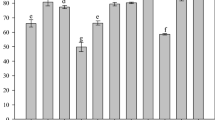Summary
Ogiri was prepared from seeds of fluted pumpkin in the traditional way. Microorganisms associated with the fermentation were identified asBacillus sp.,Staphylococcus aureus,Pseudomonas sp. andLactobacillus sp. The temperature increased to 40°C during the fermentation, while the pH first increased to 7.8 then dropped to 6.0 by the end of fermentation. The characteristic taste and strong aroma of the ogiri is attributed to the proteolytic and lipolytic activities of the isolates.
Résumé
On a préparé l'ogiri à partir de graines de potiron à cannelures à la manière traditionnelle. Les microorganismes associés à la fermentation ont été identifiés commeBacillus sp.,Staphylococcus aureus, Pseudomonas sp. etLactobacillus sp. La température monte à 40°C pendant la fermentation, tandis que le pH augmente d'abord à 7.8 pour décroître ensuite à 6.0 à la fin de la fermentation. Le goût caractéristique et l'arôme fort de l'ogiri sont attribuables aux activités protéolytiques et lipolytiques des isolats.
Similar content being viewed by others
References
Achinewhu, S. C. (1983) Chemical and nutrient composition of fermented products from plant foods.Nigerian Food Journal 1, 115–117.
Antai, S. P. &Ibrahim, M. H. (1986) Microorganisms associated with African locust bean (Parkia fillicoidea Welw) fermentation for ‘dawadawa’ production.Journal of Applied Bacteriology 61, 145–148.
Board, R. G. (1983)A Modern Introduction to Food Microbiology. Blackwell Scientific Publication, London.
Buchanan, R. E. &Gibbons, N. E. (1974)Bergey's Manual of Determinative Bacteriology. Williams and Wilkins, Baltimore.
Collins, C. N. &Lyne, P. M. (1976)Microbiology Methods. Butterworths, London.
Frazier, W. C. (1977)Food Microbiology. Tata McGraw-Hill, New Delhi.
Odunfa, S. A. (1981) Microbiology and amino acid composition of ogiri —a food condiment from fermented melon seeds.Die Nahrung 25, 811–816.
Oyenuga, V. A. (1968)Nigeria's Foods and Feeding stuffs, Ibadan, Ibadan University Press.
Sierra, G. (1957) A simple method for the detection of lipolytic activity of microorganisms and some observations on the contact between cells and fatty substrates.Antone van Leuwenhoek 25, 15–22.
Skerman, V. B. D. (1967)A Guide to the Identification of the Genera of Bacteria. Williams and Wilkins, Baltimore.
Author information
Authors and Affiliations
Rights and permissions
About this article
Cite this article
Odibo, F.J.C., Umeh, A.I. Microbiology of the fermentation ofTelfaria seeds for ogiri production. World J Microbiol Biotechnol 5, 217–222 (1989). https://doi.org/10.1007/BF01741846
Received:
Accepted:
Issue Date:
DOI: https://doi.org/10.1007/BF01741846




